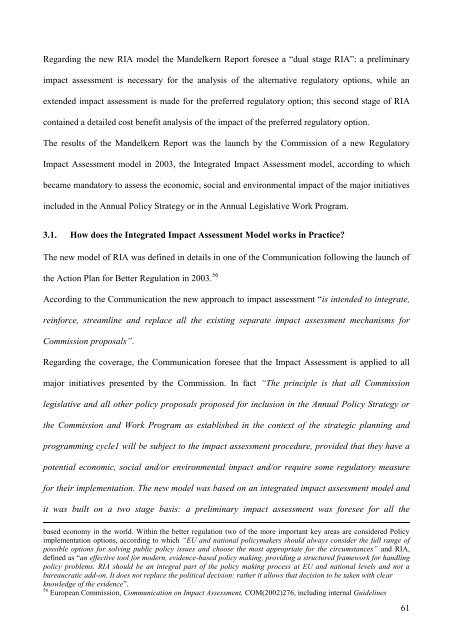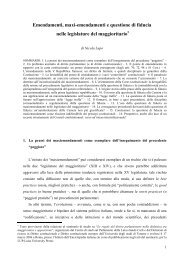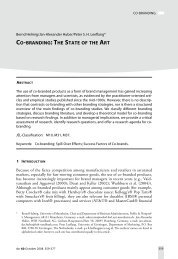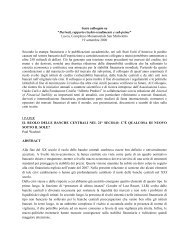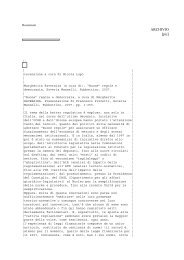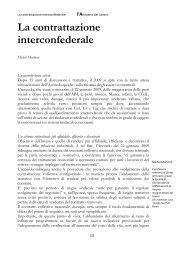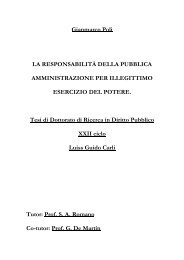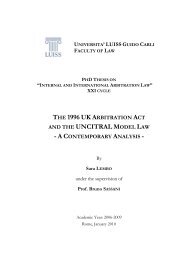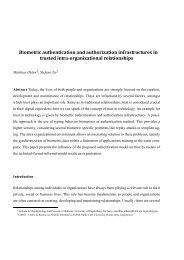The rebates, which consist in granting a lump sum discount to the ...
The rebates, which consist in granting a lump sum discount to the ...
The rebates, which consist in granting a lump sum discount to the ...
Create successful ePaper yourself
Turn your PDF publications into a flip-book with our unique Google optimized e-Paper software.
Regard<strong>in</strong>g <strong>the</strong> new RIA model <strong>the</strong> Mandelkern Report foresee a “dual stage RIA”: a prelim<strong>in</strong>aryimpact assessment is necessary for <strong>the</strong> analysis of <strong>the</strong> alternative regula<strong>to</strong>ry options, while anextended impact assessment is made for <strong>the</strong> preferred regula<strong>to</strong>ry option; this second stage of RIAconta<strong>in</strong>ed a detailed cost benefit analysis of <strong>the</strong> impact of <strong>the</strong> preferred regula<strong>to</strong>ry option.<strong>The</strong> results of <strong>the</strong> Mandelkern Report was <strong>the</strong> launch by <strong>the</strong> Commission of a new Regula<strong>to</strong>ryImpact Assessment model <strong>in</strong> 2003, <strong>the</strong> Integrated Impact Assessment model, accord<strong>in</strong>g <strong>to</strong> <strong>which</strong>became manda<strong>to</strong>ry <strong>to</strong> assess <strong>the</strong> economic, social and environmental impact of <strong>the</strong> major <strong>in</strong>itiatives<strong>in</strong>cluded <strong>in</strong> <strong>the</strong> Annual Policy Strategy or <strong>in</strong> <strong>the</strong> Annual Legislative Work Program.3.1. How does <strong>the</strong> Integrated Impact Assessment Model works <strong>in</strong> Practice?<strong>The</strong> new model of RIA was def<strong>in</strong>ed <strong>in</strong> details <strong>in</strong> one of <strong>the</strong> Communication follow<strong>in</strong>g <strong>the</strong> launch of<strong>the</strong> Action Plan for Better Regulation <strong>in</strong> 2003. 56Accord<strong>in</strong>g <strong>to</strong> <strong>the</strong> Communication <strong>the</strong> new approach <strong>to</strong> impact assessment “is <strong>in</strong>tended <strong>to</strong> <strong>in</strong>tegrate,re<strong>in</strong>force, streaml<strong>in</strong>e and replace all <strong>the</strong> exist<strong>in</strong>g separate impact assessment mechanisms forCommission proposals”.Regard<strong>in</strong>g <strong>the</strong> coverage, <strong>the</strong> Communication foresee that <strong>the</strong> Impact Assessment is applied <strong>to</strong> allmajor <strong>in</strong>itiatives presented by <strong>the</strong> Commission. In fact “<strong>The</strong> pr<strong>in</strong>ciple is that all Commissionlegislative and all o<strong>the</strong>r policy proposals proposed for <strong>in</strong>clusion <strong>in</strong> <strong>the</strong> Annual Policy Strategy or<strong>the</strong> Commission and Work Program as established <strong>in</strong> <strong>the</strong> context of <strong>the</strong> strategic plann<strong>in</strong>g andprogramm<strong>in</strong>g cycle1 will be subject <strong>to</strong> <strong>the</strong> impact assessment procedure, provided that <strong>the</strong>y have apotential economic, social and/or environmental impact and/or require some regula<strong>to</strong>ry measurefor <strong>the</strong>ir implementation. <strong>The</strong> new model was based on an <strong>in</strong>tegrated impact assessment model andit was built on a two stage basis: a prelim<strong>in</strong>ary impact assessment was foresee for all <strong>the</strong>based economy <strong>in</strong> <strong>the</strong> world. With<strong>in</strong> <strong>the</strong> better regulation two of <strong>the</strong> more important key areas are considered Policyimplementation options, accord<strong>in</strong>g <strong>to</strong> <strong>which</strong> “EU and national policymakers should always consider <strong>the</strong> full range ofpossible options for solv<strong>in</strong>g public policy issues and choose <strong>the</strong> most appropriate for <strong>the</strong> circumstances” and RIA,def<strong>in</strong>ed as “an effective <strong>to</strong>ol for modern, evidence-based policy mak<strong>in</strong>g, provid<strong>in</strong>g a structured framework for handl<strong>in</strong>gpolicy problems. RIA should be an <strong>in</strong>tegral part of <strong>the</strong> policy mak<strong>in</strong>g process at EU and national levels and not abureaucratic add-on. It does not replace <strong>the</strong> political decision: ra<strong>the</strong>r it allows that decision <strong>to</strong> be taken with clearknowledge of <strong>the</strong> evidence”.56 European Commission, Communication on Impact Assessment, COM(2002)276, <strong>in</strong>clud<strong>in</strong>g <strong>in</strong>ternal Guidel<strong>in</strong>es61


